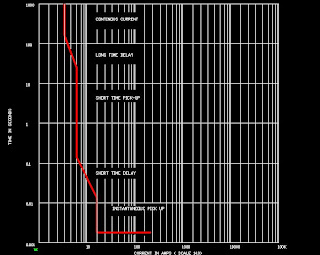Time current Curve for Switching Devices
For every switching device, time current curve is very important in order to know switching behavior of that switching device.

Now as per characteristic given above, its easily depict that there will be three section for TCC ( Time-Current-Characteristics).
- Continuous current/Long time Characteristic.
- Short time current
- Instantaneous current.
Breaker will not trip, until current is 100%, but in case of continuous overload of 105% to 130%, breaker will trip depending up on long time delay, in co-ordination with upstream breaker.
Take an example of figure. In this figure X axis is considered as current, where 1 unit is 10Amps.
And Y axis is Time.
So as in present case, Breaker used having Rating plug of 40Amps. So in case of 100% of load in breaker, that is ( 4x10 =40Amps), breaker will not trip and will go to infinite time as shown in upper portion of characteristic.
But if current will rise to 130% , that is 52Amps, it will trip after a long time delay of nearly 100 secs.
2) Short Time Characteristic:
Short Time Characteristic / Inverse Time Characteristic can consider as discriminative/ selective/tracking of load operating condition.
In other words, the circuit breaker will carry continuous short time current, for which it has been designed. And it will allow downstream breakers to clear the short circuit fault. In case of failure of downstream protection, breaker will active after short time, and will disconnect the circuit.
In figure, shown above, short time pick up will operate for 1.5 to 6 times of rating plug current. As observed, at 60A, breaker will trip after short time of nearly 0.1 sec.
To control breaker in short time characteristic to trip, breaker will wait for short time delay. In order to allow tripping of downstream protection devices.
Short time delay: Short time delay can be either of two types. Either fixed delay or
Fixed Delay : This will trip breaker after fix time delay, irrespective of other pre-programming modes.
I2 t ramp : This will trip breaker after certain adjustable time delay. This will give better co-ordination with downstream breakers.

Instantaneous Setting: When Breaker Will operate for any value between 2 to 40 times of rating plug, without any time delay, it will term as Instantaneous setting.
In our case, for 40 Amps breaker, at 10 times of current multiple of rating plug, i.e. 40x10=400Amps breaker will trip within 0.01 seconds.
I have just contributed towards this issue, what I was aware about. If any thing wrong or missing, please feel free to point it out.
Thanks.
Good Anas... Keep going...
ReplyDeletethnx selva....I will keep updating with different topicss..
ReplyDelete